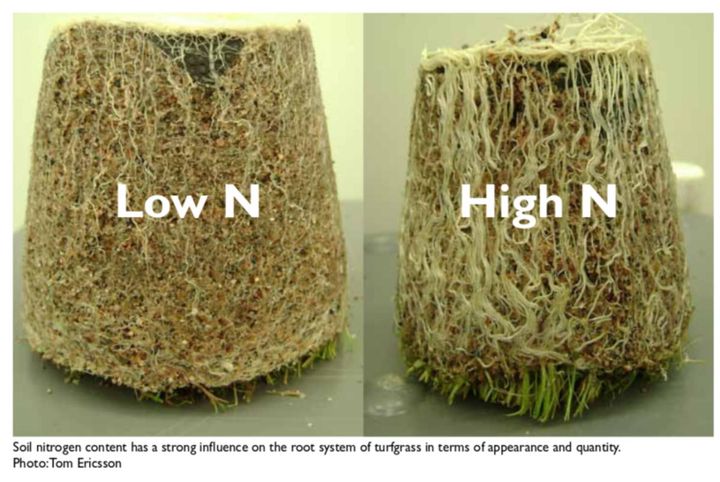2 similar approaches to turfgrass nutrition, with 1 notable difference

At first appearance, the demand-driven fertilization of STERF seems almost the same as the growth potential (GP) and MLSN approach. If you are not familiar with this approach from STERF, you can download their Precision Fertilisation – from theory to practice handbook, written by Tom Ericsson, Karin Blombäck and Agnar Kvalbein.
And I recommend you do download it. It is a great explanation of turfgrass nutrient use and requirements in only 20 pages.
First, the similarities. These quotations will sound familiar, but they are not from me. These are quotes from the Precision Fertilisation handbook – text in [ ] brackets is mine:
“fertilisation can be adapted based on the nitrogen requirement of the grass”
“light and heat control the growth potential of grass”
“warm summer days lower the nutrient requirement” [of cool season grasses adapted to a Nordic climate]
“when photosynthesis is slower, there is a decrease in the growth capacity of grass and thus also in its nutrient requirement”
“nitrogen is the nutrient that grass plants require most”
“By controlling the nitrogen concentration in the leaves through fertilisation, the growth rate is also controlled. A growth rate corresponding to 60% of maximum growth is often sufficient to produce a surface with good playing qualities. However, if the turf needs to repair some form of damage, the growth rate needs to lie around the maximum capacity for a period and therefore the nitrogen concentration also needs to be higher.
An experienced greenkeeper can judge from the colour of the grass whether the fertilisation level is right or wrong. The amount of clippings produced also sends a clear signal about the nitrogen status of the grass.”
“Since the potential growth of grass is controlled by the availability of light, heat, and water, the fertilisation level must be adapted to the growing conditions.”
[When the growth capacity is reduced:] “The same argument applies when the cutting height of the turf is lowered before competitions. When the leaf area is reduced, the capacity of the grass to capture solar energy is also reduced. This decreases the growth capacity and the nutrient requirement. In order to avoid changes in the growth pattern of the grass above and below the ground and to maintain leaf structure and carbohydrate levels in the tissues, the fertilisation intensity must be decreased.” [see also this on the lower nutrient requirement of stressed turf]
“Adding extra potassium in late summer/autumn to turf which already contains a surplus of this compound therefore has no additional effect on the ability of the grass to survive low temperatures. Addition of extra phosphorus in the spring when the soil temperature is low is also superfluous when a well-balanced fertiliser is supplied in small, frequent doses. As discussed, a moderate lack of nitrogen poses no serious problems for the health of turfgrass and in fact actually increases the quality of the turf.”
So what is the difference between demand-driven fertilization of STERF and the MLSN approach I use? It is accounting for nutrient supply from the soil.
I say, follow the approach exactly as described by Ericsson et al. in their Precision Fertilisation, but if the soil is above the MLSN guideline for a particular element, then that element does not need to be applied as fertilizer, because the soil can supply enough to meet the grass requirements.
Ericsson et al. write that “greens built according to USGA norms have a low capacity to bind and supply nutrients to the grass. On this type of green, it is very important that the fertiliser compound used contains all essential nutrients.” I would say that the fertilizer does not need to contain all essential nutrients, if the soil can supply them. And if the soil has nutrient levels above the MLSN guideline, then I am confident the soil can supply them. If the soil will drop below the MLSN guideline, then I agree, it is important that the fertilizer compound used contain that element.